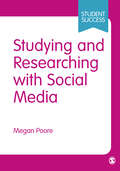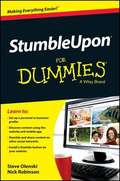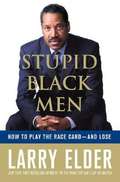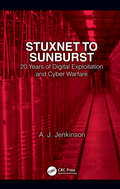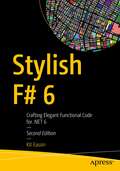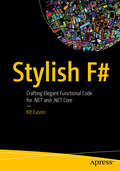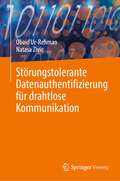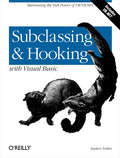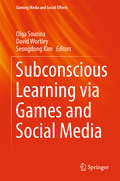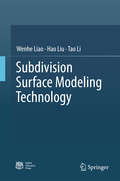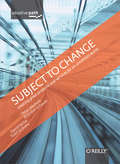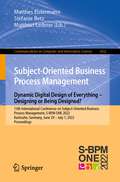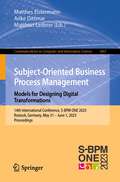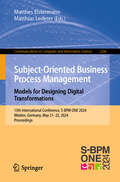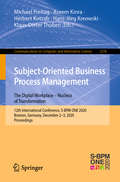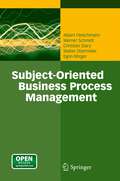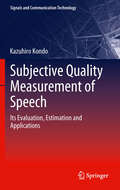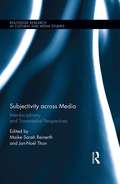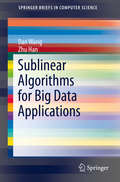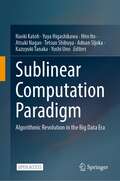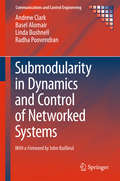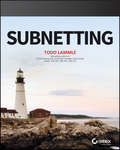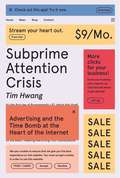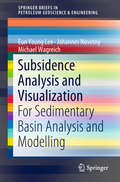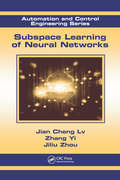- Table View
- List View
Studying and Researching with Social Media (Student Success)
by Megan PooreWondering what your lecturers are looking for in a blog post? Asking yourself how that’s different from writing an essay (or a wiki page)? Unsure if Twitter really can be used to build your online profile as a researcher? If you want – or need – to integrate social media tools into your studies and research, this practical book is your one-stop shop. Megan Poore shares the secrets of how to harness the power of social media tools to improve your academic productivity. Inside, you’ll find out how to: ... write a good blog post ... contribute to a wiki ... maximise your grades when creating an audio-visual presentation ... find and share the latest research via Twitter ... keep safe online. Featuring handy illustrations and exercises, as well as guidance on broader issues such as copyright, avoiding plagiarism, and cyberbullying, you’ll find out all you need to successfully use social media to support your study and research. Visit the Studying and Researching with Social Media blog which accompanies the book, sharing tips and guidance on using social media to improve your study and research skills. The Student Success series are essential guides for students of all levels. From how to think critically and write great essays to planning your dream career, the Student Success series helps you study smarter and get the best from your time at university. Visit the SAGE Study Skills hub for tips and resources for study success!
StumbleUpon For Dummies
by Steve Olenski Nick RobinsonDiscover new and interesting online content based on your interests!StumbleUpon helps you discover new and interesting content on the Internet based on your specific interests. With this helpful For Dummies guide, you will learn to complete a profile that alerts StumbleUpon what topics interest you and assists in making your online perusing interesting and productive. Coverage explains how the Stumble button allows StumbleUpon to learn more about you and what type of content you like to view and it also helps that particular piece of content turn up higher in other users' searches.Gets you started with setting up a profile, using the site and mobile app, and installing the browserOffers guidance for Stumbling and sharing content on other social networksExplains how to create a channel and use Paid DiscoveryShows you how to install a Stumble button on your site to encourage people to Stumble your contentWith StumbleUpon For Dummies, you've stumbled upon the ideal guide to get you started with this exciting engine!
Stupid Black Men: How to Play the Race Card - and Lose
by Larry ElderIS LIFE UNFAIR FOR BLACK AMERICANS? IS RACIAL EQUALITY THE ANSWER TO EVERY QUESTION OF PUBLIC POLICY? IS A HUGE GROUP OF CITIZENS BEING KEPT DOWN BY "THE MAN"? RADIO HOST AND BESTSELLING AUTHOR Larry Elder has made a career out of being a thorn in the side of the conventional-wisdom crowd. He deflates the pompous and points out the completely logical truths hidden behind the nutty rhetoric and out-of-control pandering of politicians and the so-called leaders of a variety of special-interest groups. In Stupid Black Men, he takes on the mind-set of those people who always capture the most media attention-as well as masses of public money-people who say that racism is the root of all problems and who end up hurting precisely those they claim to be helping. Whether they are demagogues like Al Sharpton, established politicians like Hillary Clinton, or entertainers like Danny Glover, no one escapes Elder's cogent arguments and rapier wit. His sometimes hilarious and always infuriating examples of wrong-headedness skewer not just politicians for their smugness and hypocrisy but also actors, educators, religious leaders, and the "mainscream media" for keeping the story in the headlines. But Elder has a positive message, too: though they are fewer-and generally not as loudmouthed-there are leaders and role models today who want to sweep away race-based whining and urge everyone in America to share in the hard work, smart thinking, and optimism that make this country great.
Stuxnet to Sunburst: 20 Years of Digital Exploitation and Cyber Warfare
by Andrew JenkinsonStuxnet to Sunburst: 20 Years of Digital Exploitation and Cyberwarfare takes the reader on a journey from the terrorist attacks of 9/11 onwards and the massive insatiable appetite, focus and investment by the Five Eyes agencies, in particular the U.S., to build capability of digital eavesdropping and industrial espionage. With tens of trillions of dollars moving throughout hundreds of thousands of staff,and many contractors draining the country of intelligence and technical capability, the quest was simple and the outcome horrifying. No one in the world has connected the dots, until now. From digital eavesdropping and manipulation of the agencies to Stuxnet, this book covers how the world's first use of digital code and digital certificates for offensive purposes against the Iranians and their nuclear power facilities, caused collateral damage. Proceeding to today's SolarWinds attack, code-named Sunburst, the same methods of exploitation and manipulation originally used by the agencies are now being used against companies and governments with devastating effects. The solarWinds breach has caused knock-on breaches to thousands of client companies including the U.S. government and is estimated to cost more than one trillion dollars. The monster has truly been turned against its creator and due to the lack of security and defence, breaches are occurring daily at an alarming rate. The U.S. and UK governments have little to no answer. Teh book also contains a chapter on breaches within the COVID-19 sector from research to immunisation and the devastating December 2020 breach of SolarWinds.
Stylish F# 6: Crafting Elegant Functional Code for .NET 6
by Kit EasonWhy just get by in F# when you can program in style. This book goes beyond syntax and into design. It provides F# developers with best practices, guidance, and advice to write beautiful, maintainable, and correct code. This second edition, fully updated for .NET 6 and F# 6, includes all new coverage of anonymous records, the task {} computation expression, and the relationship between types and modules. Stylish F# 6 covers every design decision that a developer makes in constructing F# programs, helping you make the most educated and valuable design choices at every stage of code development. You will learn about the design of types and function signatures, the benefits of immutability, and the uses of partial function application. You will understand best practices for writing APIs to be used by F#, C#, and other languages. Each carefully vetted design choice is supported with compelling examples, illustrations, and rationales. What You Will Learn Know why, when, and how to code in immutable styleUse collection functions, piping, and function composition to build working software quicklyBe aware of the techniques available to bring error handling into the mainstream of program logicOptimize F# code for maximum performanceIdentify and implement opportunities to use function injection to improve program designAppreciate the methods available to handle unknown data valuesUnderstand asynchronous and parallel programming in F#, and how it differs from C# asynchronous programmingExploit records and anonymous records as low-overhead, easily comparable containers for structured data Who This Book Is ForAny developer who writes F# code and wants to write it better
Stylish F#: Crafting Elegant Functional Code for .NET and .NET Core
by Kit EasonWhy just get by in F# when you can program in style! This book goes beyond syntax and into design. It provides F# developers with best practices, guidance, and advice to write beautiful, maintainable, and correct code. Stylish F# covers every design decision that a developer makes in constructing F# programs, helping you make the most educated and valuable design choices at every stage of code development. You will learn about the design of types and function signatures, the benefits of immutability, and the uses of partial function application. You will understand best practices for writing APIs to be used by F#, C#, and other languages. Each carefully vetted design choice is supported with compelling examples, illustrations, and rationales. What You'll Learn Know why, when, and how to code in immutable styleUse collection functions, piping, and function composition to build working software quicklyBe aware of the techniques available to bring error handling into the mainstream of program logicOptimize F# code for maximum performanceIdentify and implement opportunities to use function injection to improve program designAppreciate the methods available to handle unknown data valuesUnderstand asynchronous and parallel programming in F#, and how it differs from C# asynchronous programming Who This Book Is ForAny developer who writes F# code and wants to write it better
Störungstolerante Datenauthentifizierung für drahtlose Kommunikation
by Obaid Ur-Rehman Natasa ZivicDieses Buch gibt einen Einblick in die Herausforderungen der Datenauthentifizierung über drahtlose Kommunikationskanäle. Die Autoren gehen davon aus, dass die etablierten Standard-Authentifizierungsmechanismen nicht ausreichen, um Daten wie Sprache, Bilder und Videos über drahtlose Kanäle zu authentifizieren, da die drahtlose Kommunikation durch zahlreiche Störungen gekennzeichnet ist. Die Autoren schlagen neue Mechanismen vor, die auf so genannten Soft-Authentifizierungsalgorithmen basieren, die einige Änderungen an den zu schützenden Daten tolerieren. Die Autoren erklären, dass das Ziel dieser Algorithmen darin besteht, tolerant gegenüber inhaltlichen Änderungen auf Grund von Übertragungsfehler zu sein, aber dennoch in der Lage zu sein, Fälschungen zu erkennen. Ein weiterer Vorteil der Soft-Authentifizierungsalgorithmen besteht darin, dass sie in der Lage sind, die veränderten Stellen zu identifizieren und sie nach Möglichkeit zu korrigieren. Die Autoren zeigen, wie man dies erreicht, indem man die Datenmerkmale mit Hilfe von fehlerkorrigierenden Codes schützt. · Erörtert Methoden zur Authentifizierung von Daten (insbesondere von Bildern) bei Übertragungsstörungen, die bei der drahtlosen Kommunikation auftreten; · Stellt eine neue Klasse von Soft-Authentifizierungsmethoden vor, die anstelle der üblichen Hard-Authentifizierungsmethoden verwendet werden, um geringfügige Änderungen der Bilddaten zu tolerieren; · Verfügt über Authentifizierungsmethoden, die auf der Verwendung von Authentifizierungscodes und digitalen Wasserzeichen basieren
Subclassing and Hooking with Visual Basic: Harnessing the Full Power of VB/VB.NET
by Stephen TeilhetSubclassing & Hooking with Visual Basic offers developers a unique way to customize Windows behavior.Windows is a message-based system. Every action you request creates one or more messages to carry out the action. These messages are passed between objects and carry with them information that gives the recipient more detail on how to interpret and act upon the message.With Subclassing and the Windows hooking mechanism ("hooks"), you can manipulate, modify, or even discard messages bound for other objects within the operating system, in the process changing the way the system behaves. What kinds of results can you achieve using the power of subclassing and hooking? Here are just a few of the possibilities:Determine when a window is being activated or deactivated and respond to this change.Display descriptions of menu items as the mouse moves across them.Disallow a user to move or resize a window.Determine where the mouse cursor is and respond accordingly.Determine when the display resolution has been changed.Monitor the system for a low system resource condition.Modify or disallow keystrokes sent to a window or a control.Create an automated testing application.Determine when an application is idle.Along with this power comes responsibility; Windows is very unforgiving if subclassing and hooking are used incorrectly. Subclassing & Hooking with Visual Basic demonstrates the various techniques for intercepting messages bound for one or more windows or controls: the intercepted message can be left in its original state or modified; afterwards, the message can be sent to its original destination or discarded.For both VB 6 and VB.NET developers, Subclassing & Hooking with Visual Basic opens up a wealth of possibilities that ordinarily would be completely unavailable, or at least not easy to implement.
Subconscious Learning via Games and Social Media
by Olga Sourina David Wortley Seongdong KimThis book provides a detailed update on the applications of Serious Games in Healthcare and Education sector. In short, it provides an all rounded research and industry updates about the current and future advances in this area. These are the two sectors that are developing rapidly with direct applications of serious games. With advances in technologies and a new perspective on patient engagement and public expectations, the healthcare sector is increasingly turning to serious games to solve problems. Subconscious Learning via Games and Social Media will share expert opinions on the development and application of game technologies for health-related serious games. Our commercial and non-commercial expert comes from different aspects of the healthcare system from clinicians to therapist. The scope ranges from population health to specific medical domain applications. In the education sector, digital games have a great potential to improve learning of both adults and children. It is important to understand how to design games that could create long term behavioral change rather than short term alterations. In these chapters, we discuss how the serious games should be designed and deployed for both adults and children.
Subdivision Surface Modeling Technology
by Tao Li Hao Liu Wenhe LiaoThis book offers a comprehensive introduction to Subdivision Surface Modeling Technology focusing not only on fundamental theories but also on practical applications. It furthers readers’ understanding of the contacts between spline surfaces and subdivision surfaces, enabling them to master the Subdivision Surface Modeling Technology for analyzing subdivision surfaces. Subdivision surface modeling is a popular technology in the field of computer aided design (CAD) and computer graphics (CG) thanks to its ability to model meshes of any topology. The book also discusses some typical Subdivision Surface Modeling Technologies, such as interpolation, fitting, fairing, intersection, as well as trimming and interactive editing. It is a valuable tool, enabling readers to grasp the main technologies of subdivision surface modeling and use them in software development, which in turn leads to a better understanding of CAD/CG software operations.
Subject To Change: Adaptive Path on Design (Adaptive Path)
by Peter Merholz Todd Wilkens Brandon Schauer David VerbaTo achieve success in today's ever-changing and unpredictable markets, competitive businesses need to rethink and reframe their strategies across the board. Instead of approaching new product development from the inside out, companies have to begin by looking at the process from the outside in, beginning with the customer experience. It's a new way of thinking-and working-that can transform companies struggling to adapt to today's environment into innovative, agile, and commercially successful organizations.Companies must develop a new set of organizational competencies: qualitative customer research to better understand customer behaviors and motivations; an open design process to reframe possibilities and translate new ideas into great customer experiences; and agile technological implementation to quickly prototype ideas, getting them from the whiteboard out into the world where people can respond to them.In Subject to Change: Creating Great Products and Services for an Uncertain World, Adaptive Path, a leading experience strategy and design company, demonstrates how successful businesses can-and should-use customer experiences to inform and shape the product development process, from start to finish.
Subject-Oriented Business Process Management. Dynamic Digital Design of Everything – Designing or being designed?: 13th International Conference on Subject-Oriented Business Process Management, S-BPM ONE 2022, Karlsruhe, Germany, June 29–July 1, 2022, Proceedings (Communications in Computer and Information Science #1632)
by Matthias Lederer Matthes Elstermann Stefanie BetzThis book constitutes the refereed proceedings of the 13th International Conference onSubject-Oriented Business Process Management, S-BPM ONE 2022, held in Karlsruhe, Germany, during June 29–July 1, 2022.The 7 full papers and 4 short papers included in this book were carefully reviewed andselected from 15 submissions. They were organized in topical sections as follows: technology; application; and short papers.
Subject-Oriented Business Process Management. Models for Designing Digital Transformations: 14th International Conference, S-BPM ONE 2023, Rostock, Germany, May 31 – June 1, 2023, Proceedings (Communications in Computer and Information Science #1867)
by Matthias Lederer Matthes Elstermann Anke DittmarThis book constitutes the refereed proceedings of the 14th International Conference on Subject-Oriented Business Process Management, S-BPM ONE 2023, held in Rostock, Germany, during May 31–June 1, 2023.The 10 full papers and 9 short papers included in this book were carefully reviewed and selected from 24 submissions. They were organized in topical sections as follows: management issues and people; development and requirements; modeling, technology and infrastructure.
Subject-Oriented Business Process Management. Models for Designing Digital Transformations: 15th International Conference, S-BPM ONE 2024, Weiden, Germany, May 21–22, 2024, Proceedings (Communications in Computer and Information Science #2206)
by Matthias Lederer Matthes ElstermannThis book constitutes the refereed post proceedings of the 15th International Conference on Subject-Oriented Business Process Management, S-BPM ONE 2024, held in Weiden, Germany, during May 21–22, 2024. The 14 full papers and 8 short papers included in this book were carefully reviewed and selected from 30 submissions. These papers have been organized in the following topical sections: Processes And Data; Subject-Oriented Modeling, Philosophy, and Technology; Processes and Sustainability; Good Process Practices.
Subject-Oriented Business Process Management. The Digital Workplace – Nucleus of Transformation: 12th International Conference, S-BPM ONE 2020, Bremen, Germany, December 2-3, 2020, Proceedings (Communications in Computer and Information Science #1278)
by Herbert Kotzab Michael Freitag Hans-Jörg Kreowski Klaus-Dieter Thoben Aseem KinraThis book constitutes the refereed proceedings of the 12th International Conference on Subject-Oriented Business Process Management, S-BPM ONE 2020, held in Bremen, Germany, in December 2020. Due to the COVID-19 pandemic the conference was held online. The 10 full papers and 5 short papers were thoroughy reviewed and selected from 25 submissions. The volume also presents 1 keynote paper. The papers are thematically organized according to the following sections: subject-oriented business processing – syntax and semantics; cyber-physical and assistance systems; process mining and the Internet of actors and behaviors; Industry 4.0; various views on business process management.
Subject-Oriented Business Process Management: Second International Conference, S-bpm One 2010, Karlsruhe, Germany, October 14, 2010 Selected Papers (Communications In Computer And Information Science #138)
by Werner Schmidt Albert Fleischmann Christian Stary Egon Börger Stefan ObermeierActivities performed in organizations are coordinated via communication between the people involved. The sentences used to communicate are naturally structured by subject, verb, and object. The subject describes the actor, the verb the action and the object what is affected by the action. Subject-oriented Business Process Management (S-BPM) as presented in this book is based on this simple structure which enables process-oriented thinking and process modeling. S-BPM puts the subject of a process at the center of attention and thus deals with business processes and their organizational environment from a new perspective, meeting organizational requirements in a much better way than traditional approaches. Subjects represent agents of an action in a process, which can be either technical or human (e.g. a thread in an IT system or a clerk). A process structures the actions of each subject and coordinates the required communication among the subjects. S-BPM provides a coherent procedural framework to model and analyze business processes: its focus is the cooperation of all stakeholders involved in the strategic, tactical, and operational issues, sharing their knowledge in a networked structure. The authors illustrate how each modeling activity through the whole development lifecycle can be supported through the use of appropriate software tools. The presentation style focuses on professionals in industry, and on students specializing in process management or organizational modeling. Each chapter begins with a summary of key findings and is full of examples, hints, and possible pitfalls. An interpreter model, a toolbox, and a glossary summarizing the main terms complete the book. The web site www.i2pm.net provides additional software tools and further material.
Subjective Quality Measurement of Speech
by Kazuhiro KondoIt is becoming crucial to accurately estimate and monitor speech quality in various ambient environments to guarantee high quality speech communication. This practical hands-on book shows speech intelligibility measurement methods so that the readers can start measuring or estimating speech intelligibility of their own system. The book also introduces subjective and objective speech quality measures, and describes in detail speech intelligibility measurement methods. It introduces a diagnostic rhyme test which uses rhyming word-pairs, and includes: An investigation into the effect of word familiarity on speech intelligibility. Speech intelligibility measurement of localized speech in virtual 3-D acoustic space using the rhyme test. Estimation of speech intelligibility using objective measures, including the ITU standard PESQ measures, and automatic speech recognizers.
Subjectivity across Media: Interdisciplinary and Transmedial Perspectives (Routledge Research in Cultural and Media Studies)
by Jan-Noël Thon Maike Sarah ReinerthMedia in general and narrative media in particular have the potential to represent not only a variety of both possible and actual worlds but also the perception and consciousness of characters in these worlds. Hence, media can be understood as "qualia machines," as technologies that allow for the production of subjective experiences within the affordances and limitations posed by the conventions of their specific mediality. This edited collection examines the transmedial as well as the medium-specific strategies employed by the verbal representations characteristic for literary texts, the verbal-pictorial representations characteristic for comics, the audiovisual representations characteristic for films, and the interactive representations characteristic for video games. Combining theoretical perspectives from analytic philosophy, cognitive theory, and narratology with approaches from phenomenology, psychosemiotics, and social semiotics, the contributions collected in this volume provide a state-of-the-art map of current research on a wide variety of ways in which subjectivity can be represented across conventionally distinct media.
Sublinear Algorithms for Big Data Applications
by Zhu Han Dan WangThe brief focuses on applying sublinear algorithms to manage critical big data challenges. The text offers an essential introduction to sublinear algorithms, explaining why they are vital to large scale data systems. It also demonstrates how to apply sublinear algorithms to three familiar big data applications: wireless sensor networks, big data processing in Map Reduce and smart grids. These applications present common experiences, bridging the theoretical advances of sublinear algorithms and the application domain. Sublinear Algorithms for Big Data Applications is suitable for researchers, engineers and graduate students in the computer science, communications and signal processing communities.
Sublinear Computation Paradigm: Algorithmic Revolution in the Big Data Era
by Hiro Ito Yushi Uno Naoki Katoh Yuya Higashikawa Atsuki Nagao Tetsuo Shibuya Adnan Sljoka Kazuyuki TanakaThis open access book gives an overview of cutting-edge work on a new paradigm called the “sublinear computation paradigm,” which was proposed in the large multiyear academic research project “Foundations of Innovative Algorithms for Big Data.” That project ran from October 2014 to March 2020, in Japan. To handle the unprecedented explosion of big data sets in research, industry, and other areas of society, there is an urgent need to develop novel methods and approaches for big data analysis. To meet this need, innovative changes in algorithm theory for big data are being pursued. For example, polynomial-time algorithms have thus far been regarded as “fast,” but if a quadratic-time algorithm is applied to a petabyte-scale or larger big data set, problems are encountered in terms of computational resources or running time. To deal with this critical computational and algorithmic bottleneck, linear, sublinear, and constant time algorithms are required.The sublinear computation paradigm is proposed here in order to support innovation in the big data era. A foundation of innovative algorithms has been created by developing computational procedures, data structures, and modelling techniques for big data. The project is organized into three teams that focus on sublinear algorithms, sublinear data structures, and sublinear modelling. The work has provided high-level academic research results of strong computational and algorithmic interest, which are presented in this book.The book consists of five parts: Part I, which consists of a single chapter on the concept of the sublinear computation paradigm; Parts II, III, and IV review results on sublinear algorithms, sublinear data structures, and sublinear modelling, respectively; Part V presents application results. The information presented here will inspire the researchers who work in the field of modern algorithms.
Submodularity in Dynamics and Control of Networked Systems
by Andrew Clark Basel Alomair Linda Bushnell Radha PoovendranThis book presents a framework for the control of networked systems utilizing submodular optimization techniques. The main focus is on selecting input nodes for the control of networked systems, an inherently discrete optimization problem with applications in power system stability, social influence dynamics, and the control of vehicle formations. The first part of the book is devoted to background information on submodular functions, matroids, and submodular optimization, and presents algorithms for distributed submodular optimization that are scalable to large networked systems. In turn, the second part develops a unifying submodular optimization approach to controlling networked systems based on multiple performance and controllability criteria. Techniques are introduced for selecting input nodes to ensure smooth convergence, synchronization, and robustness to environmental and adversarial noise. Submodular optimization is the first unifying approach towards guaranteeing both performance and controllability with provable optimality bounds in static as well as time-varying networks. Throughout the text, the submodular framework is illustrated with the help of numerical examples and application-based case studies in biological, energy and vehicular systems. The book effectively combines two areas of growing interest, and will be especially useful for researchers in control theory, applied mathematics, networking or machine learning with experience in submodular optimization but who are less familiar with the problems and tools available for networked systems (or vice versa). It will also benefit graduate students, offering consistent terminology and notation that greatly reduces the initial effort associated with beginning a course of study in a new area.
Subnetting
by Todd LammleMaster the fundamental concept at the heart of professional networking Subnetting is the aspiring network professional's guide to the concepts and practices at the core of the field. By dividing a single physical network into smaller subnetworks, you gain greater control of performance, access, and security. While the concept is simple, the actual practice is complex--yet it is an essential skill for networking professionals, and a major skill tested on the CCENT and CompTIA Network+ exams. This book shows you everything you need to know about constructing IP addresses, VSLM, and route summarization to help you build your skill set on a strong foundation. The IPv4 address has 32 bits available, which can be divided into host ID and network ID; the number of bits assigned to the network ID determines the balance between total subnetworks and devices allowed--the trick is determining the most efficient balance for a particular network. Subnetting allows you to borrow bits from the host to allow for more networks, and subnet masks are used to determine switching and routing priority. This book delves into the mechanisms and practices you need to know, including networking fundamentals, rules of IP addresses, supernetting, variable length subnet mask, IPv6, and more: Master the fundamental topic at the heart of the Cisco Certified Entry Networking Technician and CompTIA Network+ certifications Improve network performance using subnetworks to avoid high-usage "clogs" Utilize network partitioning to confine breaches or viruses and improve security Construct efficient solutions to problems of allocation and range With clear guidance from an industry expert and a practical perspective geared toward real-world situations, Subnetting offers an outstanding introduction to this essential foundational concept.
Subprime Attention Crisis: Advertising and the Time Bomb at the Heart of the Internet (FSG Originals x Logic)
by Tim HwangFrom FSGO x Logic: a revealing examination of digital advertising and the internet's precarious foundationIn Subprime Attention Crisis, Tim Hwang investigates the way big tech financializes attention. In the process, he shows us how digital advertising—the beating heart of the internet—is at risk of collapsing, and that its potential demise bears an uncanny resemblance to the housing crisis of 2008. From the unreliability of advertising numbers and the unregulated automation of advertising bidding wars, to the simple fact that online ads mostly fail to work, Hwang demonstrates that while consumers’ attention has never been more prized, the true value of that attention itself—much like subprime mortgages—is wildly misrepresented. And if online advertising goes belly-up, the internet—and its free services—will suddenly be accessible only to those who can afford it. Deeply researched, convincing, and alarming, Subprime Attention Crisis will change the way you look at the internet, and its precarious future.FSG Originals × Logic dissects the way technology functions in everyday lives. The titans of Silicon Valley, for all their utopian imaginings, never really had our best interests at heart: recent threats to democracy, truth, privacy, and safety, as a result of tech’s reckless pursuit of progress, have shown as much. We present an alternate story, one that delights in capturing technology in all its contradictions and innovation, across borders and socioeconomic divisions, from history through the future, beyond platitudes and PR hype, and past doom and gloom. Our collaboration features four brief but provocative forays into the tech industry’s many worlds, and aspires to incite fresh conversations about technology focused on nuanced and accessible explorations of the emerging tools that reorganize and redefine life today.
Subsidence Analysis and Visualization: For Sedimentary Basin Analysis and Modelling (SpringerBriefs in Petroleum Geoscience & Engineering)
by Eun Young Lee Johannes Novotny Michael WagreichThis book provides a comprehensive introduction to techniques for quantitative subsidence analysis and visualization with example applications. Subsidence analysis is an essential step to understand basin evolution through geologic time and space in the study of sediments and sedimentary basins. Quantifying techniques have been developed and applied in many basin research projects to evaluate total, tectonic and thermal subsidence. They are also a pre-requisite for basin evolution modelling. Recent studies have applied visualization techniques to understand regional subsidence contexts and trends, which confirmed that three-dimensional visualization of the basin subsidence is highly helpful to gain insight into basin evolution. In this book, we show how geoscience and computer science can be effectively combined in advanced basin analysis, especially in terms of basin subsidence. Each type of subsidence analysis is introduced with example applications. In particular we present a study of the Vienna basin using BasinVis, a MATLAB-based program for analyzing and visualizing basin subsidence. Given its breadth of coverage, this book will benefit students in undergraduate and postgraduate courses and provide helpful information for research projects and industry applications.
Subspace Learning of Neural Networks (Automation and Control Engineering)
by Jian Cheng Lv Zhang Yi Jiliu ZhouUsing real-life examples to illustrate the performance of learning algorithms and instructing readers how to apply them to practical applications, this work offers a comprehensive treatment of subspace learning algorithms for neural networks. The authors summarize a decade of high quality research offering a host of practical applications. They demonstrate ways to extend the use of algorithms to fields such as encryption communication, data mining, computer vision, and signal and image processing to name just a few. The brilliance of the work lies with how it coherently builds a theoretical understanding of the convergence behavior of subspace learning algorithms through a summary of chaotic behaviors.
